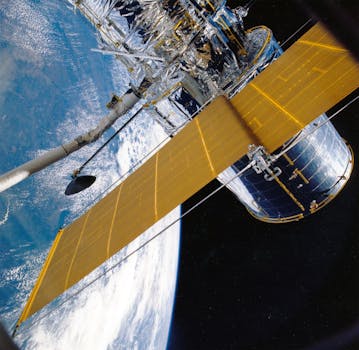The Future of Satellites: Revolutionizing Global Connectivity
The future of satellites is poised to revolutionize global connectivity, enabling faster and more reliable communication, navigation, and data transfer. With advancements in technology, satellites are becoming increasingly important for various applications, including telecommunications, Earth observation, and space exploration.

The Future of Satellites: Revolutionizing Global Connectivity
The future of satellites is poised to revolutionize global connectivity, enabling faster and more reliable communication, navigation, and data transfer. With advancements in technology, satellites are becoming increasingly important for various applications, including telecommunications, Earth observation, and space exploration. The focus keyword Future of Satellites is becoming increasingly important as we look to the next generation of satellite technology.
Satellites have been a crucial part of modern life for decades, providing services such as television broadcasting, telecommunications, and navigation. However, the next generation of satellites is expected to be even more powerful and versatile, with capabilities such as high-speed internet, advanced Earth observation, and deep space exploration. The use of satellites in Future of Satellites is expected to increase exponentially in the coming years, with new applications and services being developed all the time.
Advancements in Satellite Technology
One of the key drivers of the future of satellites is advancements in technology. New materials and manufacturing techniques are enabling the production of smaller, lighter, and more powerful satellites. This is making it possible to launch multiple satellites at once, reducing the cost and increasing the efficiency of satellite launches. Additionally, advancements in propulsion systems and power generation are enabling satellites to operate for longer periods and travel further into space.
Another important development is the use of reusable launch vehicles, which are reducing the cost of accessing space and making it possible to launch satellites more frequently. This is enabling companies to deploy constellations of satellites, which can provide global coverage and enable new services such as high-speed internet and Earth observation. The Future of Satellites is looking bright, with many companies investing heavily in satellite technology and launch capabilities.
Applications of Satellites
Satellites have a wide range of applications, including telecommunications, Earth observation, and space exploration. Telecommunications satellites provide services such as television broadcasting, mobile phone connectivity, and internet access. Earth observation satellites are used for applications such as weather forecasting, crop monitoring, and disaster response. Space exploration satellites are used to study the universe and search for signs of life beyond Earth.
In addition to these traditional applications, satellites are also being used for new and innovative purposes. For example, satellites are being used to provide high-speed internet access to remote and underserved communities. They are also being used to track and monitor climate change, and to provide early warning systems for natural disasters. The Future of Satellites is exciting, with many new applications and services being developed all the time.
Challenges and Opportunities
While the future of satellites is exciting, there are also challenges and opportunities that need to be addressed. One of the key challenges is the increasing amount of space debris in Earth’s orbit, which can pose a risk to operational satellites and other space-based assets. Another challenge is the need for international cooperation and regulation, to ensure that the use of satellites is safe, sustainable, and responsible.
Despite these challenges, the future of satellites is full of opportunities. The use of satellites is expected to increase exponentially in the coming years, with new applications and services being developed all the time. This is creating new opportunities for companies and individuals to innovate and invest in satellite technology, and to develop new products and services that take advantage of the capabilities of satellites. The Future of Satellites is looking bright, with many exciting developments on the horizon.